ROCKETS AND SPACECRAFTS Nikulina Mariya MX-15-1 Rocket engines
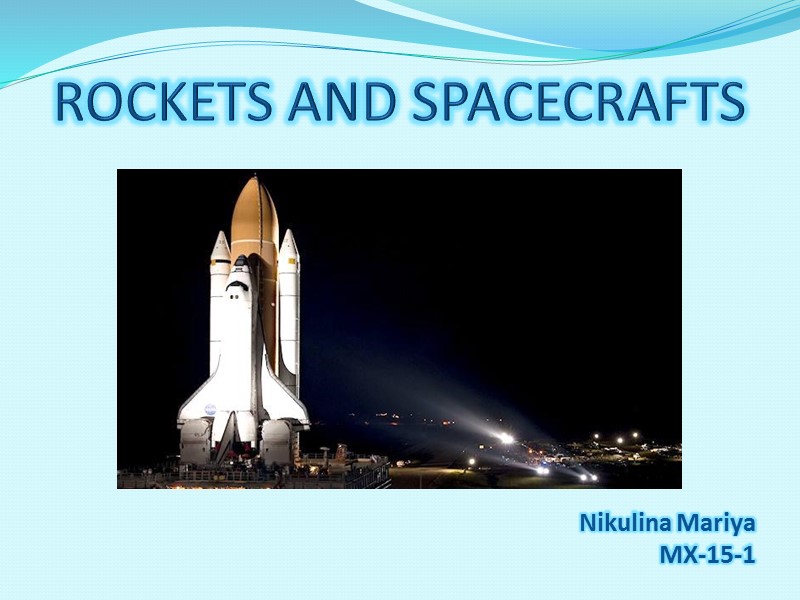
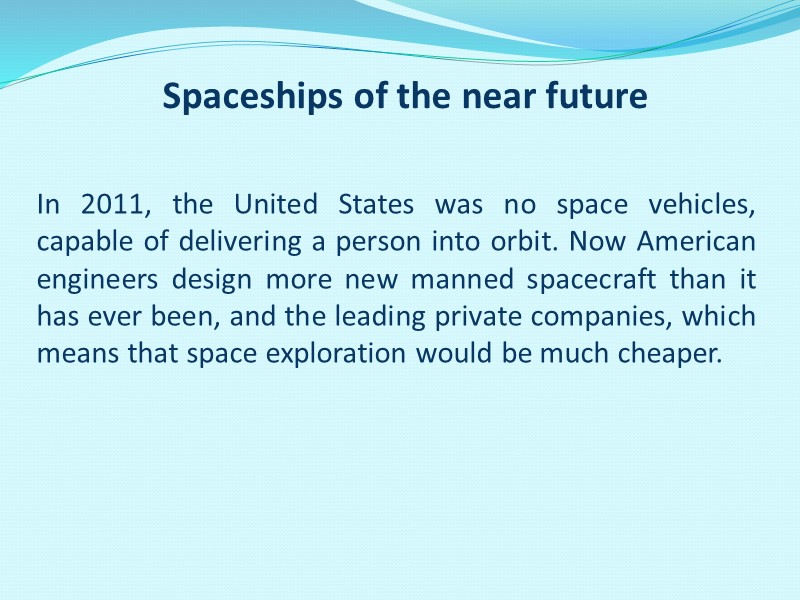
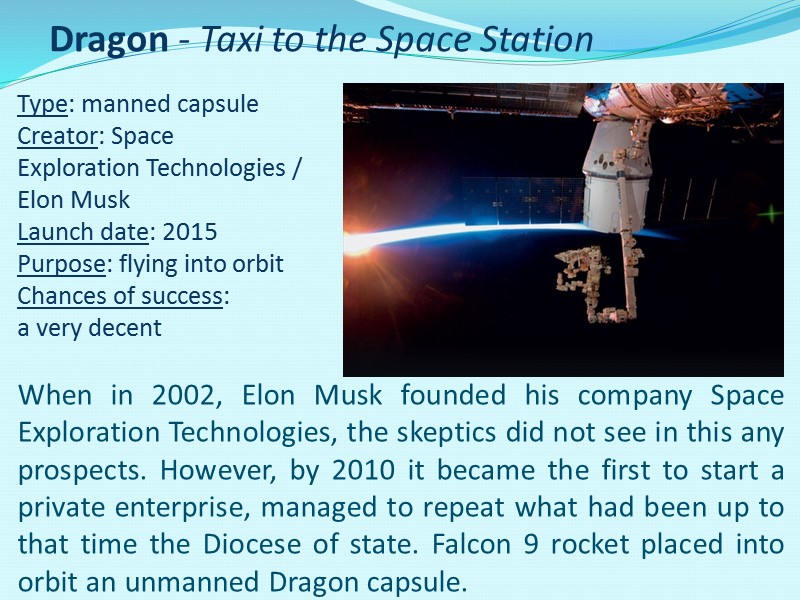

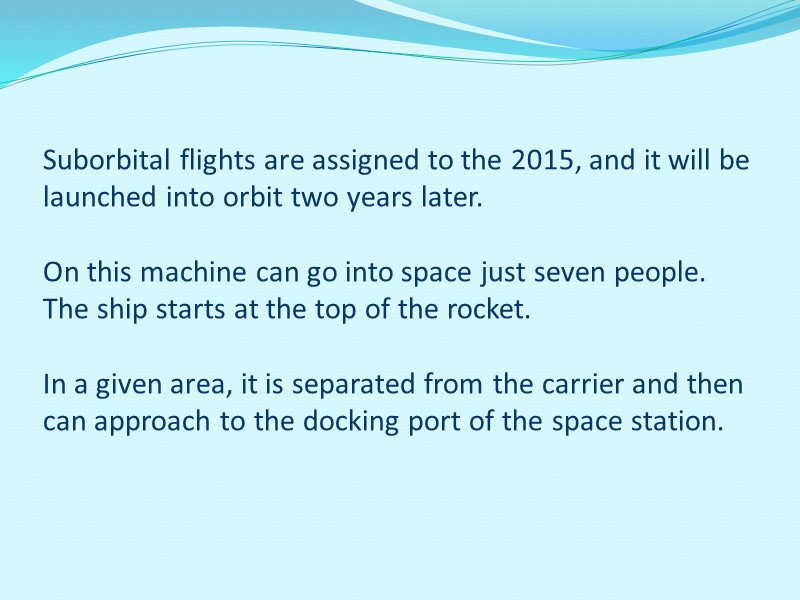



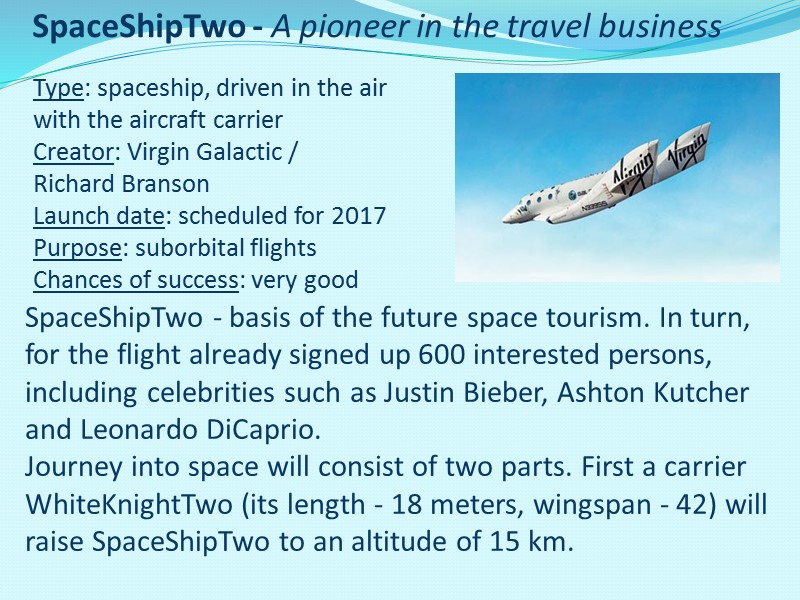
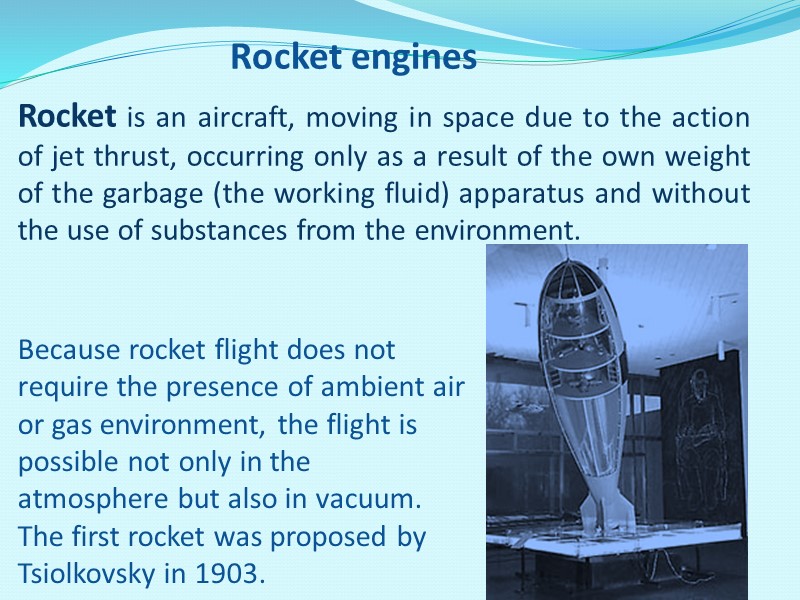



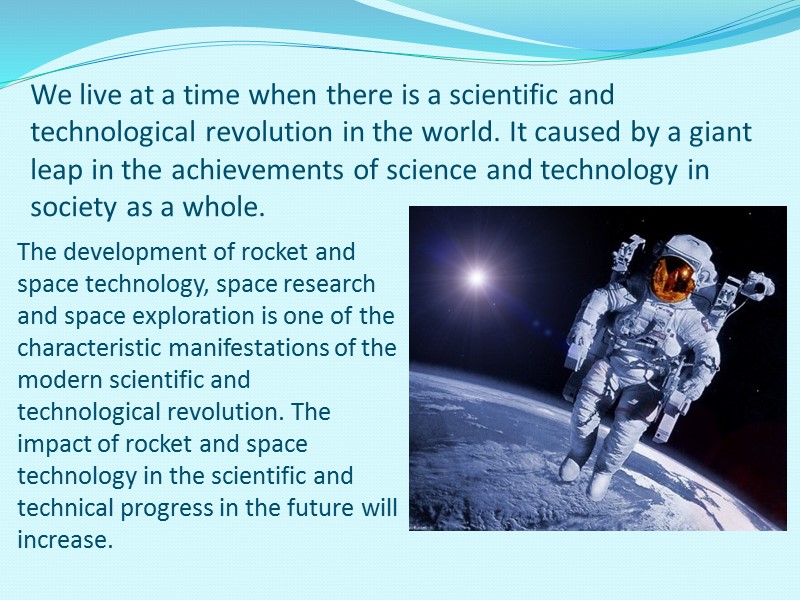


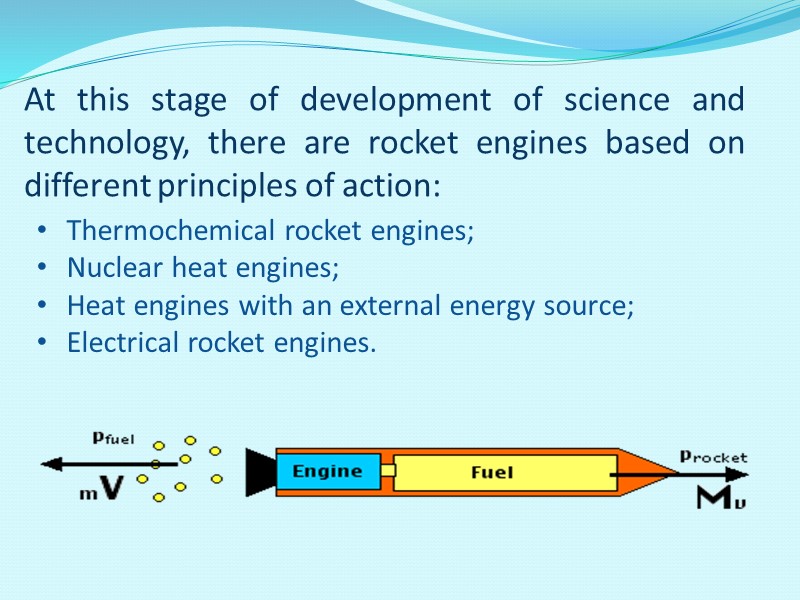
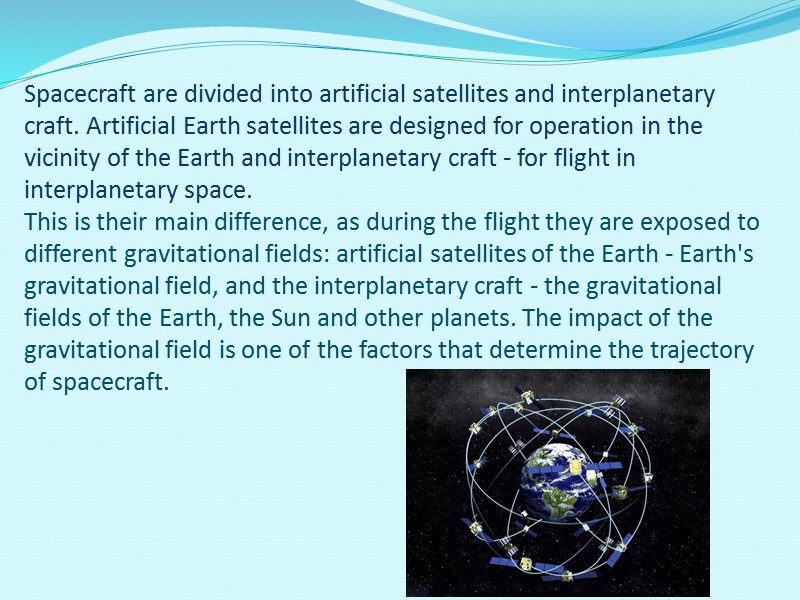


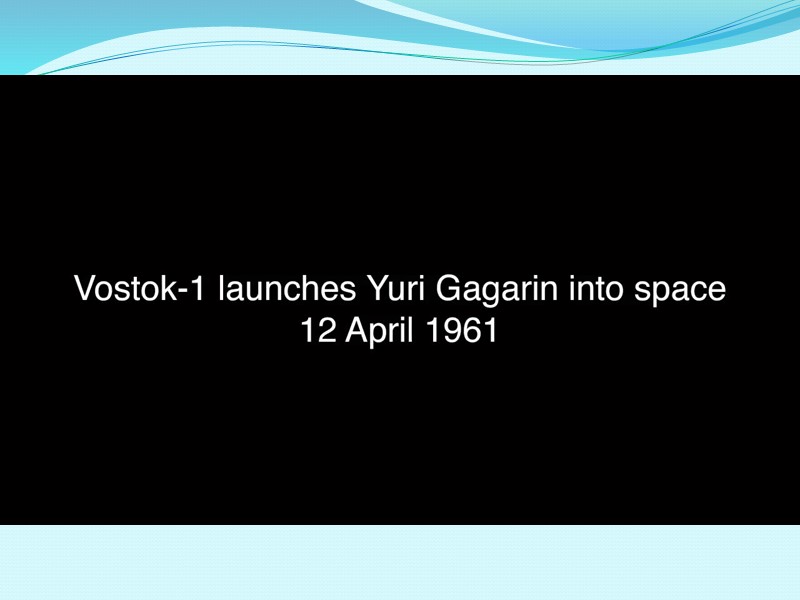
134-angl_rakety3.pptx
- Количество слайдов: 25
 ROCKETS AND SPACECRAFTS Nikulina Mariya MX-15-1
ROCKETS AND SPACECRAFTS Nikulina Mariya MX-15-1
 Rocket engines Rocket is an aircraft, moving in space due to the action of jet thrust, occurring only as a result of the own weight of the garbage (the working fluid) apparatus and without the use of substances from the environment. Because rocket flight does not require the presence of ambient air or gas environment, the flight is possible not only in the atmosphere but also in vacuum. The first rocket was proposed by Tsiolkovsky in 1903.
Rocket engines Rocket is an aircraft, moving in space due to the action of jet thrust, occurring only as a result of the own weight of the garbage (the working fluid) apparatus and without the use of substances from the environment. Because rocket flight does not require the presence of ambient air or gas environment, the flight is possible not only in the atmosphere but also in vacuum. The first rocket was proposed by Tsiolkovsky in 1903.
 Combustion chamber Nozzle The simplest rocket scheme of the device Space has a large arsenal of rocket engine systems based on the use of various types of energy. But in all cases the rocket engine carries out the same task: he throws some of the rocket mass, the stock of which (the so-called working body) is inside the vehicle.
Combustion chamber Nozzle The simplest rocket scheme of the device Space has a large arsenal of rocket engine systems based on the use of various types of energy. But in all cases the rocket engine carries out the same task: he throws some of the rocket mass, the stock of which (the so-called working body) is inside the vehicle.
 At this stage of development of science and technology, there are rocket engines based on different principles of action: Thermochemical rocket engines; Nuclear heat engines; Heat engines with an external energy source; Electrical rocket engines.
At this stage of development of science and technology, there are rocket engines based on different principles of action: Thermochemical rocket engines; Nuclear heat engines; Heat engines with an external energy source; Electrical rocket engines.
 From left to right: Single-stage rocket; The two-stage missile with a transverse division; The two-stage missile with a longitudinal division. Rocket with external fuel tanks, detachable after the exhaustion of fuel in them. Arrangement of versions rockets
From left to right: Single-stage rocket; The two-stage missile with a transverse division; The two-stage missile with a longitudinal division. Rocket with external fuel tanks, detachable after the exhaustion of fuel in them. Arrangement of versions rockets
 Spacecraft are divided into artificial satellites and interplanetary craft. Artificial Earth satellites are designed for operation in the vicinity of the Earth and interplanetary craft - for flight in interplanetary space. This is their main difference, as during the flight they are exposed to different gravitational fields: artificial satellites of the Earth - Earth's gravitational field, and the interplanetary craft - the gravitational fields of the Earth, the Sun and other planets. The impact of the gravitational field is one of the factors that determine the trajectory of spacecraft.
Spacecraft are divided into artificial satellites and interplanetary craft. Artificial Earth satellites are designed for operation in the vicinity of the Earth and interplanetary craft - for flight in interplanetary space. This is their main difference, as during the flight they are exposed to different gravitational fields: artificial satellites of the Earth - Earth's gravitational field, and the interplanetary craft - the gravitational fields of the Earth, the Sun and other planets. The impact of the gravitational field is one of the factors that determine the trajectory of spacecraft.
 The trajectory of the flight of a spacecraft consists of the following sections: - Put into orbit; - The flight in outer space; - Return to the dense layers of the atmosphere and landing. Interplanetary aircraft are not returned back to Earth. They overflew the other planets and land on them or become "artificial planets" of Solar system. Artificial Earth satellites usually fly in closed orbits, which are shaped like a circle or ellipse.
The trajectory of the flight of a spacecraft consists of the following sections: - Put into orbit; - The flight in outer space; - Return to the dense layers of the atmosphere and landing. Interplanetary aircraft are not returned back to Earth. They overflew the other planets and land on them or become "artificial planets" of Solar system. Artificial Earth satellites usually fly in closed orbits, which are shaped like a circle or ellipse.
 Piloted spaceship - manned spacecraft designed to carry humans fly in space and, in particular, to transport people into space and safe return to Earth (or another planet / moon / space station). The first manned spacecraft became the Soviet ship Vostok 1, in which Yuri Gagarin made the first full-fledged space flight, circled Earth at orbital velocity.
Piloted spaceship - manned spacecraft designed to carry humans fly in space and, in particular, to transport people into space and safe return to Earth (or another planet / moon / space station). The first manned spacecraft became the Soviet ship Vostok 1, in which Yuri Gagarin made the first full-fledged space flight, circled Earth at orbital velocity.

 In 2011, the United States was no space vehicles, capable of delivering a person into orbit. Now American engineers design more new manned spacecraft than it has ever been, and the leading private companies, which means that space exploration would be much cheaper. Spaceships of the near future
In 2011, the United States was no space vehicles, capable of delivering a person into orbit. Now American engineers design more new manned spacecraft than it has ever been, and the leading private companies, which means that space exploration would be much cheaper. Spaceships of the near future
 Type: manned capsule Creator: Space Exploration Technologies / Elon Musk Launch date: 2015 Purpose: flying into orbit Chances of success: a very decent When in 2002, Elon Musk founded his company Space Exploration Technologies, the skeptics did not see in this any prospects. However, by 2010 it became the first to start a private enterprise, managed to repeat what had been up to that time the Diocese of state. Falcon 9 rocket placed into orbit an unmanned Dragon capsule. Dragon - Taxi to the Space Station
Type: manned capsule Creator: Space Exploration Technologies / Elon Musk Launch date: 2015 Purpose: flying into orbit Chances of success: a very decent When in 2002, Elon Musk founded his company Space Exploration Technologies, the skeptics did not see in this any prospects. However, by 2010 it became the first to start a private enterprise, managed to repeat what had been up to that time the Diocese of state. Falcon 9 rocket placed into orbit an unmanned Dragon capsule. Dragon - Taxi to the Space Station

 Dream Chaser - A descendant of the space shuttle Type: space plane to launch with the help of the carrier rocket Creator: Sierra Nevada Space Systems Launch date: 2016 Purpose: orbital flights Chances of success: good Dream Chaser - the space plane to deliver crews to the space station. Dream Chaser design spared from major shortcomings of the old space shuttles. In the first place now loads and crews are going to carry on alone. And secondly, now the ship will be mounted on top of the carrier rocket Atlas V. At the same time all the advantages of the shuttle will remain.
Dream Chaser - A descendant of the space shuttle Type: space plane to launch with the help of the carrier rocket Creator: Sierra Nevada Space Systems Launch date: 2016 Purpose: orbital flights Chances of success: good Dream Chaser - the space plane to deliver crews to the space station. Dream Chaser design spared from major shortcomings of the old space shuttles. In the first place now loads and crews are going to carry on alone. And secondly, now the ship will be mounted on top of the carrier rocket Atlas V. At the same time all the advantages of the shuttle will remain.
 Suborbital flights are assigned to the 2015, and it will be launched into orbit two years later. On this machine can go into space just seven people. The ship starts at the top of the rocket. In a given area, it is separated from the carrier and then can approach to the docking port of the space station.
Suborbital flights are assigned to the 2015, and it will be launched into orbit two years later. On this machine can go into space just seven people. The ship starts at the top of the rocket. In a given area, it is separated from the carrier and then can approach to the docking port of the space station.

 New Shepard - Secret ship from Amazon Type: manned capsule Creator: Blue Origin / Jeff Bezos Launch date: unknown Purpose: suborbital flights Chances of success: good According to the project, the booster in the future will be able, having thrown the capsule to suborbital altitude yourself back to the launch site, using its own engine. It is much more cost-effective scheme than catching the used stage after splashdown in the ocean. New Shepard - a conical rocket system, which takes off vertically to a height of one hundred and fifty meters, hangs there for a while, and then gently lowered to the ground by a jet stream.
New Shepard - Secret ship from Amazon Type: manned capsule Creator: Blue Origin / Jeff Bezos Launch date: unknown Purpose: suborbital flights Chances of success: good According to the project, the booster in the future will be able, having thrown the capsule to suborbital altitude yourself back to the launch site, using its own engine. It is much more cost-effective scheme than catching the used stage after splashdown in the ocean. New Shepard - a conical rocket system, which takes off vertically to a height of one hundred and fifty meters, hangs there for a while, and then gently lowered to the ground by a jet stream.
 The system consists of two parts. The capsule for the crew, in which is supported by normal atmospheric pressure, is separated from the carrier and flies to an altitude of 100 km. The engine allows the rocket to make a vertical landing not far from the launch pad. The capsule itself is then returned to the ground with the help of a parachute. Booster raises the machine from the launch pad.
The system consists of two parts. The capsule for the crew, in which is supported by normal atmospheric pressure, is separated from the carrier and flies to an altitude of 100 km. The engine allows the rocket to make a vertical landing not far from the launch pad. The capsule itself is then returned to the ground with the help of a parachute. Booster raises the machine from the launch pad.
 SpaceShipTwo - A pioneer in the travel business Type: spaceship, driven in the air with the aircraft carrier Creator: Virgin Galactic / Richard Branson Launch date: scheduled for 2017 Purpose: suborbital flights Chances of success: very good SpaceShipTwo - basis of the future space tourism. In turn, for the flight already signed up 600 interested persons, including celebrities such as Justin Bieber, Ashton Kutcher and Leonardo DiCaprio. Journey into space will consist of two parts. First a carrier WhiteKnightTwo (its length - 18 meters, wingspan - 42) will raise SpaceShipTwo to an altitude of 15 km.
SpaceShipTwo - A pioneer in the travel business Type: spaceship, driven in the air with the aircraft carrier Creator: Virgin Galactic / Richard Branson Launch date: scheduled for 2017 Purpose: suborbital flights Chances of success: very good SpaceShipTwo - basis of the future space tourism. In turn, for the flight already signed up 600 interested persons, including celebrities such as Justin Bieber, Ashton Kutcher and Leonardo DiCaprio. Journey into space will consist of two parts. First a carrier WhiteKnightTwo (its length - 18 meters, wingspan - 42) will raise SpaceShipTwo to an altitude of 15 km.
 Then jet separates from the aircraft carrier, will launch its own engines and explode into space. At an altitude of 108 kilometers, passengers great review and the curvature of the earth's surface, and the serene radiance of the Earth's atmosphere - and all this against a background of black depths of space. Tickets, which cost a quarter of a million dollars, will allow travelers to enjoy weightlessness, but just four minutes.
Then jet separates from the aircraft carrier, will launch its own engines and explode into space. At an altitude of 108 kilometers, passengers great review and the curvature of the earth's surface, and the serene radiance of the Earth's atmosphere - and all this against a background of black depths of space. Tickets, which cost a quarter of a million dollars, will allow travelers to enjoy weightlessness, but just four minutes.
 Inspiration Mars - Kiss on the Red Planet Type: interplanetary transport Creator: Foundation Inspiration Mars / Dennis Tito Launch date: 2018 Purpose: Flight to Mars Chances of success: doubtful Honeymoon (length of one and a half years) in the interplanetary expedition - an opportunity that wants to offer the chosen pair Inspiration Mars Foundation, which is headed by Dennis Tito. Tito Group expects to take advantage of a parade of the planets, which will occur in 2018 (this is a once in 15 years). "Parade" will make it possible to fly from Earth to Mars and back along the trajectory of free return, that is, without burning additional fuel. In the future, the Inspiration Mars will begin to accept applications for an expedition duration of 501 days.
Inspiration Mars - Kiss on the Red Planet Type: interplanetary transport Creator: Foundation Inspiration Mars / Dennis Tito Launch date: 2018 Purpose: Flight to Mars Chances of success: doubtful Honeymoon (length of one and a half years) in the interplanetary expedition - an opportunity that wants to offer the chosen pair Inspiration Mars Foundation, which is headed by Dennis Tito. Tito Group expects to take advantage of a parade of the planets, which will occur in 2018 (this is a once in 15 years). "Parade" will make it possible to fly from Earth to Mars and back along the trajectory of free return, that is, without burning additional fuel. In the future, the Inspiration Mars will begin to accept applications for an expedition duration of 501 days.
 Lynx with stripes - Straight into space Type: space plane capable of taking off on their own Creator: XCOR Aerospace Launch date : 2019 Purpose: suborbital flights Chances of success: quite good Lynx to exit into space need not launch vehicle, unlike other space planes. By running a specially developed for this project jets (they will be burned kerosene and liquid oxygen), Lynx will take off from the strip in a horizontal direction, as does an ordinary plane, and only speeding, cool take off along the its space trajectory. The first test flight of the apparatus can be held in the coming months.
Lynx with stripes - Straight into space Type: space plane capable of taking off on their own Creator: XCOR Aerospace Launch date : 2019 Purpose: suborbital flights Chances of success: quite good Lynx to exit into space need not launch vehicle, unlike other space planes. By running a specially developed for this project jets (they will be burned kerosene and liquid oxygen), Lynx will take off from the strip in a horizontal direction, as does an ordinary plane, and only speeding, cool take off along the its space trajectory. The first test flight of the apparatus can be held in the coming months.
